Mastering the B2B Sales Funnel
October 3, 2025
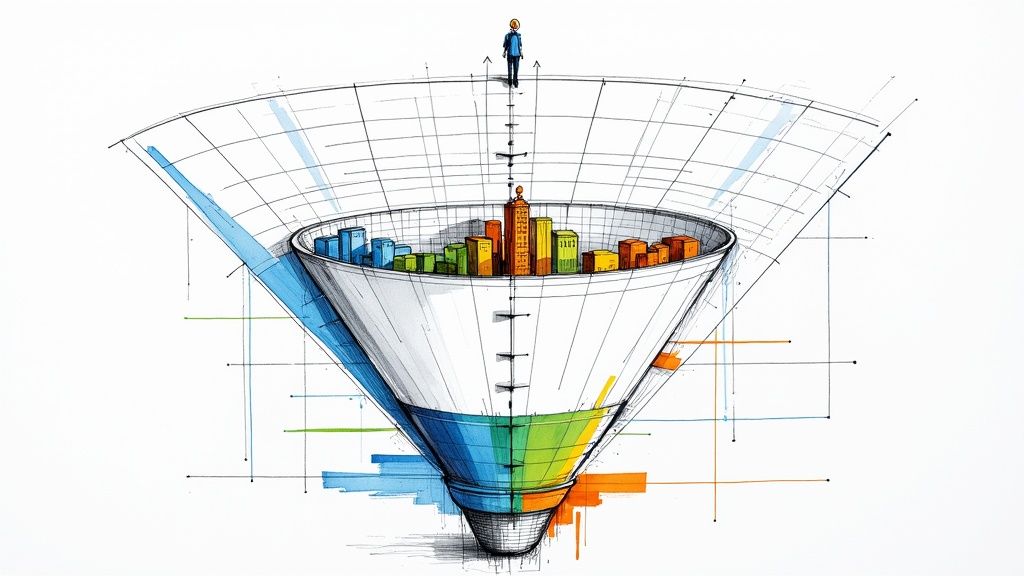
Forget rigid, outdated sales models. The B2B sales funnel is your strategic blueprint for guiding valuable business partners from their first awareness of a problem to a signed contract. Think of it less as a rigid process and more as a dynamic system for building trust and proving your worth at every turn.
Your Blueprint for Predictable B2B Growth
Imagine you’re an architect. You wouldn't just start stacking bricks and hope a building stands up. You’d create a detailed blueprint where each floor is designed to support the one above it, resulting in a stable, functional structure.
A B2B sales funnel works on the exact same principle. It provides a clear, logical framework that turns unpredictable lead generation into a consistent, measurable process for winning deals.
Without this blueprint, sales efforts feel chaotic—like trying to build without a plan. You might generate some interest here and there, but potential clients inevitably fall through the cracks because there’s no clear next step. This guide is here to demystify the entire process, moving beyond dry definitions to give you a practical roadmap for building a funnel that consistently delivers results.
Moving from Guesswork to Strategy
A well-constructed funnel transforms your sales approach from reactive guesswork to proactive strategy. It gives you a deeper understanding of your buyer's journey, allowing you to align your messaging and actions with their specific needs at each stage. This strategic alignment is what makes an effective funnel work.
A successful B2B sales funnel isn’t about pushing prospects through a series of steps. It’s about pulling them forward with value, insight, and a clear understanding of how you solve their most pressing challenges.
This structured approach lets you:
- Attract Ideal Clients: Focus your resources on businesses that are the best possible fit for your solutions, which naturally leads to a higher chance of conversion.
- Nurture Genuine Interest: Build credibility and trust by providing targeted, valuable content that speaks directly to their pain points.
- Close High-Value Deals: Guide qualified leads toward a confident decision, setting the stage for partnerships built for long-term success.
By mastering your B2B sales funnel, you're not just closing more deals; you're building a scalable engine for predictable growth. An effective funnel is a core component of any successful B2B marketing strategy, making sure every marketing dollar and sales hour is invested wisely.
Understanding Each Stage of the B2B Sales Funnel
Every successful B2B sales funnel is a guided journey. It’s about transforming a stranger dealing with a problem into a long-term business partner. This isn’t about forcing prospects through a rigid process; it’s about pulling them forward with value, insight, and a clear understanding of how you solve their most pressing challenges.
This journey unfolds across three distinct phases, each with its own goals, prospect mindset, and strategic activities.
This infographic visualizes how your marketing efforts can act like magnets, attracting a wide range of potential clients into the top of your funnel.
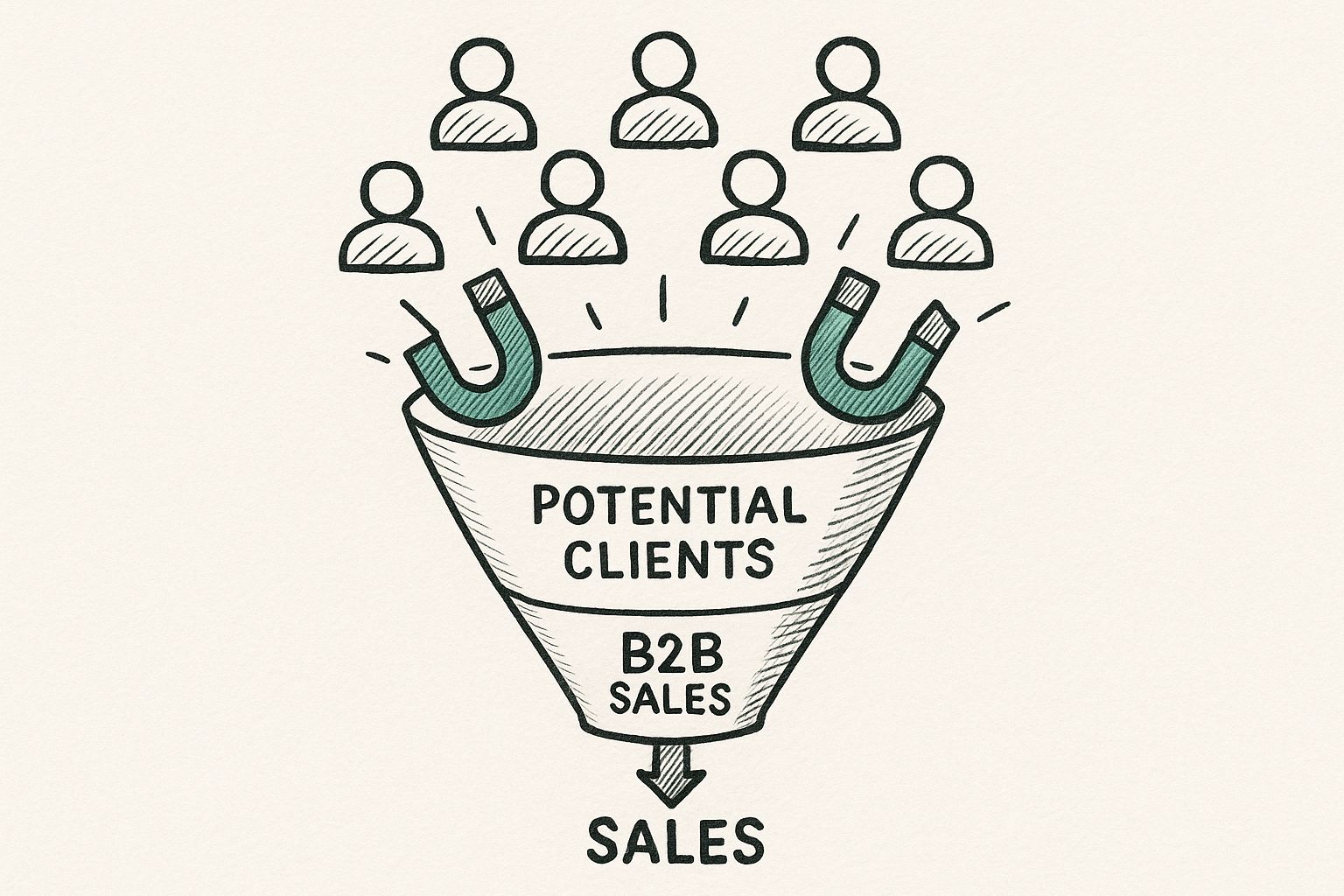
As you can see, the initial stage is all about casting a wide—yet targeted—net to draw in prospects who are just beginning their search for solutions.
Top of the Funnel (TOFU): Igniting Awareness
The Top of the Funnel, or TOFU, is where the relationship begins. At this point, your potential customers aren't thinking about your product or even your company. They are focused entirely on a problem they're experiencing or a goal they're trying to achieve.
Their mindset is one of exploration and education. They’re asking questions like, "How can we improve our project management efficiency?" or "What are the best cybersecurity practices in our industry?" They are problem-aware but not yet solution-aware.
Your primary objective here is not to sell, but to educate and attract. You want to become a trusted resource by providing high-value, no-strings-attached content that speaks directly to their business problems.
Common activities at the TOFU stage include:
- SEO-Optimized Blog Posts: Crafting articles that answer the specific questions your ideal customers are typing into Google.
- Industry Reports and White Papers: Offering in-depth research that establishes your authority and expertise on a subject.
- Engaging Webinars: Hosting educational sessions that provide actionable advice and insights into a particular business challenge.
The goal is simple: capture their attention and earn their trust, making them willing to take the next small step, like subscribing to a newsletter or downloading a guide.
Middle of the Funnel (MOFU): Building Consideration
Once a prospect has engaged with your TOFU content, they move into the Middle of the Funnel, or MOFU. At this stage, they've moved from being problem-aware to solution-aware. They know a fix for their problem exists and are now actively evaluating different options.
Their mindset shifts from broad education to specific evaluation. They're comparing features, weighing benefits, and trying to determine which approach is the best fit for their organization's unique needs. This is where you transition from being an educator to a problem-solver.
Your key objective in the MOFU stage is to nurture qualified leads by demonstrating your unique value proposition. It’s about showing them not just that a solution exists, but why your solution is the superior choice for their business.
To do this effectively, you need to provide more targeted, in-depth content that helps them build a business case for your offering.
- Case Studies: Showcase real-world examples of how you've helped similar companies overcome their challenges and achieve measurable results.
- Product Demos: Offer a firsthand look at your solution in action, allowing prospects to visualize how it would work for them.
- Comparison Guides: Create content that directly compares your solution to competitors or alternative methods, highlighting your key differentiators.
Tracking the progression through these stages is critical, as each step has its own set of challenges and metrics. For instance, according to industry benchmarks, the average conversion rate from the top of the funnel (awareness to lead) sits between 1% and 3%. As leads get warmer in the middle stage (lead to opportunity), this rate typically jumps to 10%-15%.
Bottom of the Funnel (BOFU): Driving the Decision
Finally, prospects who are convinced your solution is a strong contender move to the Bottom of the Funnel, or BOFU. They are now highly qualified and have a clear intent to make a purchase.
The mindset here is all about validation and justification. Decision-makers are looking for the final pieces of information they need to feel confident in their choice. They’re asking specific questions about pricing, implementation, and return on investment.
Your objective is simple but critical: close the deal. This requires a more personalized and direct approach from your sales team, providing the final reassurances needed to get a signature on the contract.
Activities that drive conversions at the BOFU stage include:
- Personalized Consultations or Audits: Offering one-on-one sessions to discuss their specific needs and tailor a solution.
- Detailed Proposals and Quotes: Providing clear, comprehensive documents that outline the scope, cost, and expected outcomes.
- Free Trials or Pilot Programs: Allowing key stakeholders to experience the value of your solution firsthand with minimal risk.
To help you visualize this entire process, we've put together a table summarizing each stage.
B2B Sales Funnel Stages and Objectives
This table breaks down each phase of the B2B sales funnel, detailing the primary goal, the prospect's state of mind, and the most effective activities to engage them.
Each stage of the B2B sales funnel is deeply connected to the prospect's evolving state of mind. To truly master this process, it's essential to map out these phases in detail. You can learn more about how to visualize this entire process in our guide to building a B2B customer journey map.
By aligning your tactics with their needs at every step, you create a seamless and persuasive experience that transforms initial interest into a lasting business relationship.
Aligning Content and Tactics with Funnel Stages
Knowing the stages of the B2B sales funnel is a great start, but real growth begins when you put them to work. The best way to think about your funnel is as a series of gates on a prospect's journey. Your job isn’t to force them through; it’s to give them the perfect key—the right content, the right message—so they want to unlock the next gate themselves.
When you get this alignment right, your sales process transforms from a collection of disconnected activities into a smooth, persuasive experience. Each piece of content and every touchpoint builds on the last, guiding decision-makers with confidence and clarity straight to the solution they need.
Delivering the right message at exactly the right time is the entire game. It’s how you build trust, prove your value, and make your solution feel like the only logical choice.
Attracting Prospects at the Top of the Funnel (TOFU)
At the top of the funnel, your audience isn't looking for a sales pitch. They are trying to understand a business problem, searching for answers and information, not a list of vendors. Your one and only goal here is to be the most helpful resource in the room.
The content you create for this stage has to be educational, insightful, and laser-focused on their business challenges. It's an act of giving away valuable expertise to earn their attention and establish your authority.
The most powerful TOFU strategy is to simply answer the questions your ideal customer is already asking. Become their go-to resource for industry insights, and you’ll be the first one they call when they're finally ready to talk solutions.
Here are the most effective tactics for this awareness stage:
- SEO-Optimized Articles: Go deep with blog posts that target the specific pain-point keywords your prospects are typing into search engines. A single, well-researched article can become a lead-generation engine that brings in high-intent traffic for years.
- Insightful Industry Reports: Don't just regurgitate trends. Publish original research or data-driven reports that offer a unique, compelling perspective. This is how you position your company as a genuine thought leader and earn valuable backlinks.
- Engaging Educational Webinars: Host live or on-demand webinars that teach your audience how to solve a specific, nagging problem. This format is brilliant for direct engagement and capturing highly qualified leads who are actively looking to learn.
The key is to offer immense value with zero expectation of an immediate sale. This approach builds a foundation of trust that is absolutely critical for the long B2B sales cycle.
Nurturing Leads in the Middle of the Funnel (MOFU)
Once you’ve captured their attention, prospects move into the middle of the funnel. At this point, they've identified their problem and are now actively evaluating potential solutions. Your content needs to pivot from broad education to specific, solution-oriented guidance.
This is your chance to show them how your offering directly solves their problems. The goal is to build a rock-solid case for why your approach is the best one, backing it up with hard proof and validation.
To make that happen, you need to deploy assets that connect the dots between their problem and your solution.
- Compelling Case Studies: There's nothing more powerful than showing success stories from companies they recognize. A detailed case study provides undeniable social proof and lets prospects see themselves in your clients' wins.
- In-Depth White Papers: Go deeper than a blog post by offering a comprehensive guide that breaks down a specific methodology or framework. This demonstrates your expertise and helps your internal champion build a business case.
- Automated Email Nurture Sequences: Deliver a targeted series of emails that offer more value and gently introduce your solution over time. This keeps your brand top-of-mind and guides leads toward the next logical step without being pushy.
Effectively using these assets is a core part of sales enablement. For more ideas on how to execute this, you can explore these B2B content examples for successful sales enablement and see how different formats work.
Closing Deals at the Bottom of the Funnel (BOFU)
Down at the bottom of the funnel, your prospect is on the verge of making a decision. They're weighing their final options and need concrete proof that your solution is the smartest investment for their company. Your tactics here have to become highly personalized and focused on removing any final barriers.
This stage is less about general content and more about high-touch, tailored interactions that build confidence and make the decision easy to justify to other stakeholders.
Your objective here is simple: make the choice to go with you feel clear, easy, and safe.
- High-Impact Product Demos: Forget the canned, one-size-fits-all tour. Offer personalized, one-on-one demos that focus exclusively on the prospect's unique use case. Show them exactly how your product solves their specific problems, not just what the buttons do.
- Personalized Consultations and Audits: Provide a free consultation or a strategic audit to offer tangible value upfront. This builds immense goodwill and serves as a powerful demonstration of your expertise before they've spent a dime.
- Detailed Proposals and ROI Calculators: Create comprehensive proposals that clearly lay out the scope, deliverables, and total investment. Including an ROI calculator is a game-changer that helps them sell the purchase internally to the finance team and other decision-makers.
By carefully mapping these specific tactics to each stage of your B2B sales funnel, you create a seamless and logical journey for your buyers. This strategic alignment doesn't just generate more leads; it builds momentum, fosters genuine trust, and consistently turns prospects into valuable, long-term partners.
Fueling Your Funnel with High-Quality B2B Leads
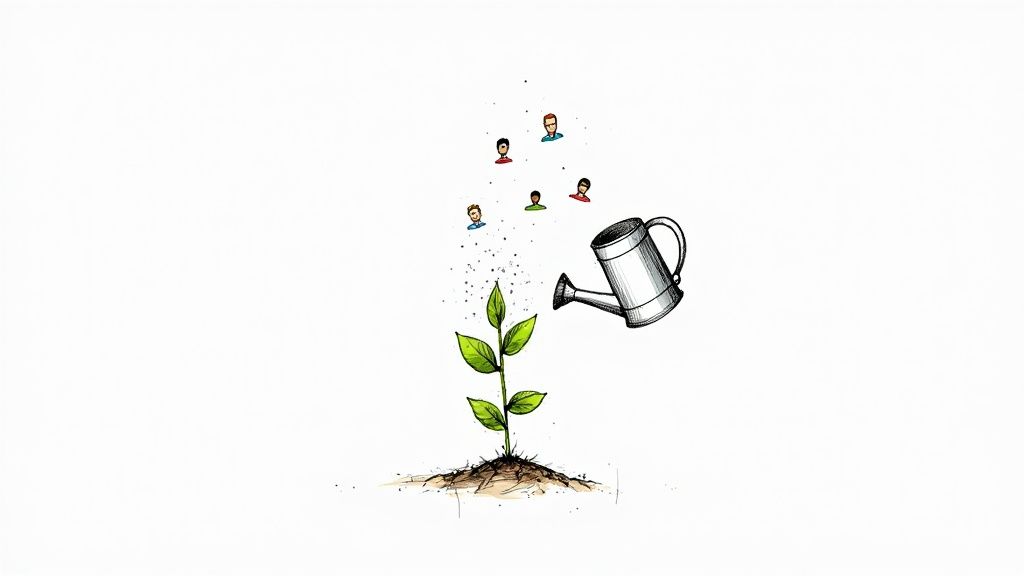
A perfectly designed B2B sales funnel is an impressive blueprint, but without a steady stream of high-quality materials, nothing gets built. Leads are the lifeblood of your funnel, yet a staggering 61% of marketers report that generating high-quality leads is their single biggest challenge.
This isn't about casting the widest net possible. It's about attracting the right businesses—those who will see immediate, undeniable value in what you offer. The secret to filling your funnel with high-intent buyers is to start with an unwavering focus on quality over quantity. This shift transforms lead generation from a numbers game into a strategic act of attracting perfect-fit partners.
Defining Your Ideal Customer Profile
Before you write a single blog post or send one outreach email, you have to know exactly who you're trying to reach. The cornerstone of any successful lead generation effort is a crystal-clear Ideal Customer Profile (ICP). An ICP is a detailed description of the company—not the person—that is a perfect fit for your solution.
Think of your ICP as a hyper-specific filter for your entire B2B sales funnel. It moves beyond basic demographics to include firmographics that truly matter:
- Industry: What specific sectors experience the problems you solve best?
- Company Size: Are you built for agile startups or established enterprises?
- Revenue: What is the typical annual revenue of a company that can afford your solution?
- Technology Stack: What other software do your best customers already use?
An ICP is your guiding star for every marketing and sales decision. When you know precisely who you’re looking for, every piece of content you create and every campaign you launch becomes infinitely more effective.
With a well-defined ICP, you stop wasting resources on businesses that were never going to convert. Instead, you can focus your energy on the strategies most likely to resonate with high-value prospects. This targeted approach is essential for any modern B2B lead generation plan.
High-Impact Lead Generation Strategies
With your ICP as your guide, you can now deploy specific tactics designed to attract decision-makers from those ideal companies. The goal is to create multiple entry points into your B2B sales funnel, each offering genuine value.
- Account-Based Marketing (ABM): Instead of broadcasting a message to a wide audience, ABM flips the model. You identify a specific list of target accounts that match your ICP and then create highly personalized campaigns designed to engage key stakeholders within those organizations.
- Strategic LinkedIn Outreach: LinkedIn is a central hub for B2B professionals. It’s an invaluable tool for identifying and connecting with decision-makers at your target accounts, sharing insightful content, and starting meaningful conversations that can lead them into your funnel.
- Targeted Content Marketing: Create valuable "lead magnets"—such as in-depth industry reports, comprehensive white papers, or exclusive webinars—that address the specific pain points of your ICP. These assets are offered in exchange for contact information, effectively turning anonymous visitors into qualified leads.
Optimizing for Conversion
Attracting the right people is only half the battle; you also need to make it easy for them to enter your funnel. This means optimizing your digital front door—your landing pages. A compelling landing page should have a clear headline, concise copy that highlights the value of your offer, and a simple form to capture essential information.
To further enhance lead capture, consider strategies like building a chatbot for lead generation that can actively engage and qualify prospects 24/7.
The journey through a B2B sales funnel requires patience and persistence. Data shows it often takes between 6 to 8 touchpoints before a lead becomes a viable sales opportunity, as 96% of website visitors aren't ready to buy on their first visit. This just highlights the importance of consistent follow-up and nurturing to guide prospects from initial interest to a final decision.
Measuring Funnel Performance with Key Metrics
A B2B sales funnel isn't just a theoretical blueprint; it's a powerful growth engine. But like any engine, it needs to be tuned and optimized with the right data. This is how you shift from merely hoping for results to intentionally creating them.
Tracking performance lets you see exactly where your efforts are paying off and, just as importantly, where potential customers are dropping out of the journey. Without metrics, you’re flying blind—unable to diagnose problems or double down on what’s working.
The right data tells the story of your customer’s journey, shining a spotlight on bottlenecks and opportunities with undeniable clarity. By focusing on a few essential Key Performance Indicators (KPIs), you can get a full view of your funnel's health and make smart decisions that directly drive revenue.
Core Funnel Metrics You Must Track
To get a clear picture of your funnel's efficiency, you need to focus on the numbers that truly matter. These metrics give you a direct line of sight into how well you’re turning interest into revenue, forming the bedrock of a data-driven sales strategy.
- Lead Conversion Rate: This is the percentage of visitors who take a specific action to become a lead, like filling out a contact form or downloading a whitepaper. A low number here might mean your top-of-funnel content isn't resonating or your landing page design needs a rethink.
- MQL-to-SQL Conversion Rate: This tracks how many of your marketing-qualified leads (MQLs) are accepted by the sales team, becoming sales-qualified leads (SQLs). A large drop-off at this stage is a classic sign of misalignment between marketing and sales on what a "good" lead actually looks like.
- Sales Cycle Length: This is the average time it takes for a lead to move from first contact to a closed deal. If your sales cycle is getting longer, it could point to friction in your process or a need for more effective lead nurturing.
- Customer Acquisition Cost (CAC): This is the total sales and marketing cost to bring a new customer on board. Knowing your CAC is non-negotiable for figuring out if your growth efforts are actually profitable and scalable.
Keep in mind, these conversion rates can change dramatically depending on who you're selling to. For B2B SaaS companies, targeting small to mid-sized businesses often yields a 39% opportunity-to-close rate. But when you shift focus to large enterprise firms, that rate can dip to 31%, a reflection of the longer, more complex buying cycles involved.
From Data to Decisions
Tracking metrics is just step one. The real value comes when you use that data to make strategic adjustments. Each KPI is a clue telling you what’s working and what isn’t, giving you the power to optimize your entire B2B sales funnel. For a deeper look, check out our guide on how to measure marketing effectiveness.
Think of your funnel metrics as a diagnostic dashboard for your growth engine. When a number looks off, it’s not a failure—it’s an opportunity to inspect the system, find the issue, and make your engine run smoother than ever before.
To get practical about assessing your sales pipeline's health, this Pipeline Coverage Calculator Guide is an invaluable resource for measuring performance.
By consistently keeping an eye on these core metrics, you create a feedback loop that fuels continuous improvement. This data-driven approach is what transforms your funnel into a reliable, predictable source of high-quality deals and sustainable business growth.
Building Your High-Performance B2B Sales Funnel
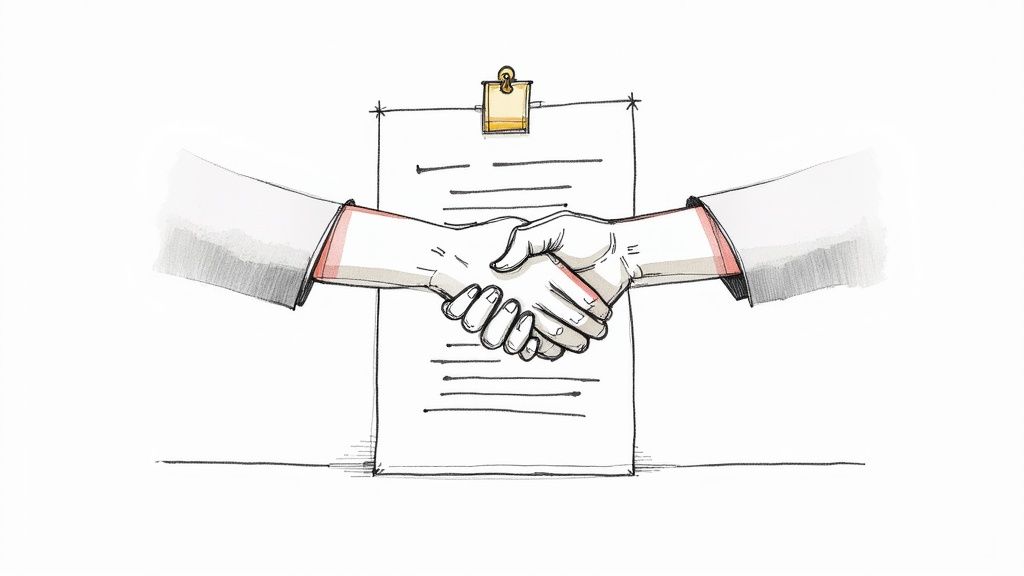
We've walked through the entire blueprint. From sparking initial awareness to finalizing a high-value deal, you now have the building blocks. But a B2B sales funnel is not a static diagram you frame and hang on the wall.
Think of it as a high-performance engine. You wouldn’t build it once and expect it to win races forever. You have to constantly tune it, test different fuels, and optimize every component for peak performance. Its success depends on relentless testing and a deep, collaborative bond between your sales and marketing teams.
Your funnel is where strategy finally meets action, transforming your business from one that reacts to opportunities to one that creates them.
A high-performance B2B sales funnel is your company’s most valuable asset. It’s a predictable, scalable machine for growth, built on a foundation of genuine value and continuous improvement.
Final Funnel-Building Checklist
As you get ready to put these strategies into practice, use this quick checklist. It’s perfect for auditing your current process or for building a new one from the ground up, making sure you don't miss any of the critical components.
- Define Your Ideal Customer Profile: Is your target audience defined with absolute, razor-sharp clarity? Every single tactic must be aimed squarely at this profile.
- Map Your Funnel Stages: Have you clearly laid out the key actions and goals for your Top-of-Funnel (TOFU), Middle-of-Funnel (MOFU), and Bottom-of-Funnel (BOFU) stages?
- Align Content to Each Stage: Does every blog post, webinar, and case study serve a specific purpose in guiding prospects to the next step?
- Establish Key Metrics: Are you tracking the vital signs of your funnel, like conversion rates, sales cycle length, and customer acquisition cost?
- Integrate Sales and Marketing: Do both teams agree on what a "good lead" is? Do they share responsibility for the funnel's success? This is non-negotiable.
- Implement a Feedback Loop: Do you have a process for regularly reviewing performance data and making small, iterative improvements?
Every "yes" on this list gets you one step closer to a funnel that doesn’t just generate leads, but one that cultivates lasting, profitable partnerships.
The path to a world-class B2B sales funnel is a journey of constant refinement. Embrace the data, listen intently to your customers, and empower your teams to work as one cohesive unit. Apply these strategies with focus and consistency, and you'll build more than just a process—you'll build your ultimate engine for sustainable growth.
Got Questions About B2B Sales Funnels?
Even the most thoughtfully designed B2B sales funnel can feel like a complex machine. Let's break down a few of the most common questions that come up when teams start building or fine-tuning their growth engine.
Think of this as a quick-reference guide to help you move forward with confidence, turning good theory into practical, revenue-driving action.
How Is a B2B Sales Funnel Different From a B2C Funnel?
The short answer? The customer. Everything flows from that one, massive difference.
A B2C funnel is built for an individual making a relatively quick, often emotional decision. Picture someone buying a new pair of running shoes—the process is personal, fast, and driven by want as much as need.
A B2B sales funnel, on the other hand, is designed for a committee of professionals making a slow, logical, and expensive decision. You aren't selling to one person; you're convincing department heads, finance teams, IT security, and legal. The journey is longer, the stakes are much higher, and the final call hinges on ROI and business impact, not personal taste.
B2C funnels are all about closing transactions. B2B funnels are about building strategic partnerships. This fundamental difference should shape every single tactic you use, from the content you create to how your sales team runs a demo.
What Are the Most Common Mistakes to Avoid?
Building a B2B funnel is an exercise in precision, and a few common missteps can easily derail your best efforts. Simply being aware of these pitfalls is the first step to sidestepping them and keeping your funnel running at peak efficiency.
Here are the critical errors I see most often:
- Misaligned Sales and Marketing Teams: This is, without a doubt, the number one point of failure. When marketing’s definition of a “qualified lead” doesn’t match what sales actually needs to close a deal, high-potential opportunities get lost in a messy handoff. This is a common and costly problem.
- Poor Lead Qualification: Pouring unqualified prospects into the top of your funnel is a fantastic way to waste everyone’s time and money. Failing to filter ruthlessly for your Ideal Customer Profile (ICP) just creates a system full of noise and very little signal.
- Ignoring the Middle of the Funnel: Many companies get excited about attracting visitors (TOFU) and closing deals (BOFU) but neglect the crucial nurturing phase in the middle. This is where you build trust and prove your value. Skipping it is like building a bridge with a giant gap in the center—it's a recipe for a leaky funnel.
How Long Should a Typical B2B Sales Cycle Be?
There’s no single answer here. The length of a B2B sales cycle is shaped by a handful of key factors, so what’s “normal” can vary wildly. A simple, lower-priced software tool might close in a few weeks. A complex, enterprise-level deal? That could easily take six to nine months or even longer.
The primary drivers of your sales cycle length are:
- Deal Size and Complexity: The bigger the price tag and the more moving parts in your solution, the longer the cycle will be. More money means more scrutiny.
- Number of Decision-Makers: Every new stakeholder added to the buying committee extends the timeline. Getting on one person's calendar is hard enough; coordinating five is a project in itself.
- Industry and Risk: Selling into highly regulated spaces like finance or healthcare naturally involves more red tape and security reviews. This adds layers of due diligence that stretch out the process.
Understanding these variables helps you set realistic expectations for your team and tailor your follow-up cadence so it feels persistent, not pushy.
Ready to transform your sales process from a series of disconnected steps into a predictable engine for growth? At Big Moves Marketing, I help B2B SaaS and AI startups build the messaging, sales tools, and launch strategies that win deals and drive revenue. Let's create a funnel that delivers results. Learn more about how we can work together at https://www.bigmoves.marketing.
%20-%20Alternate.svg)
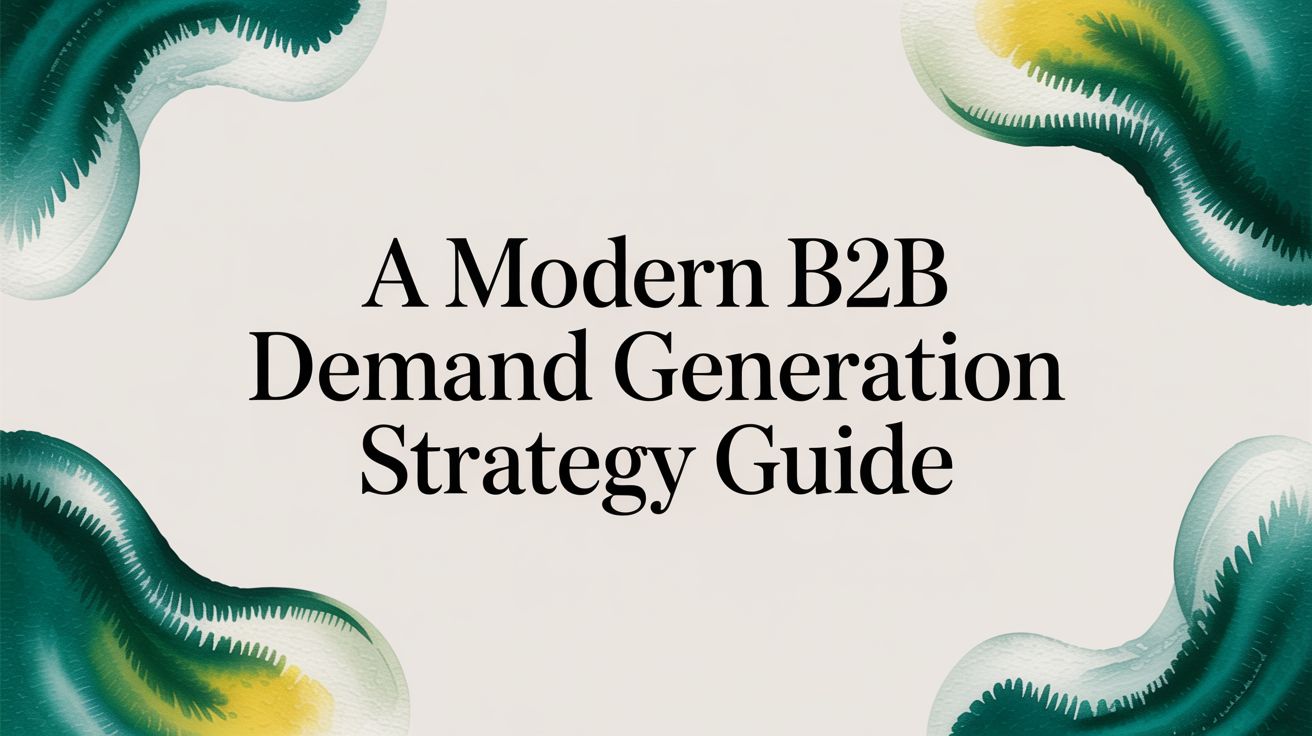
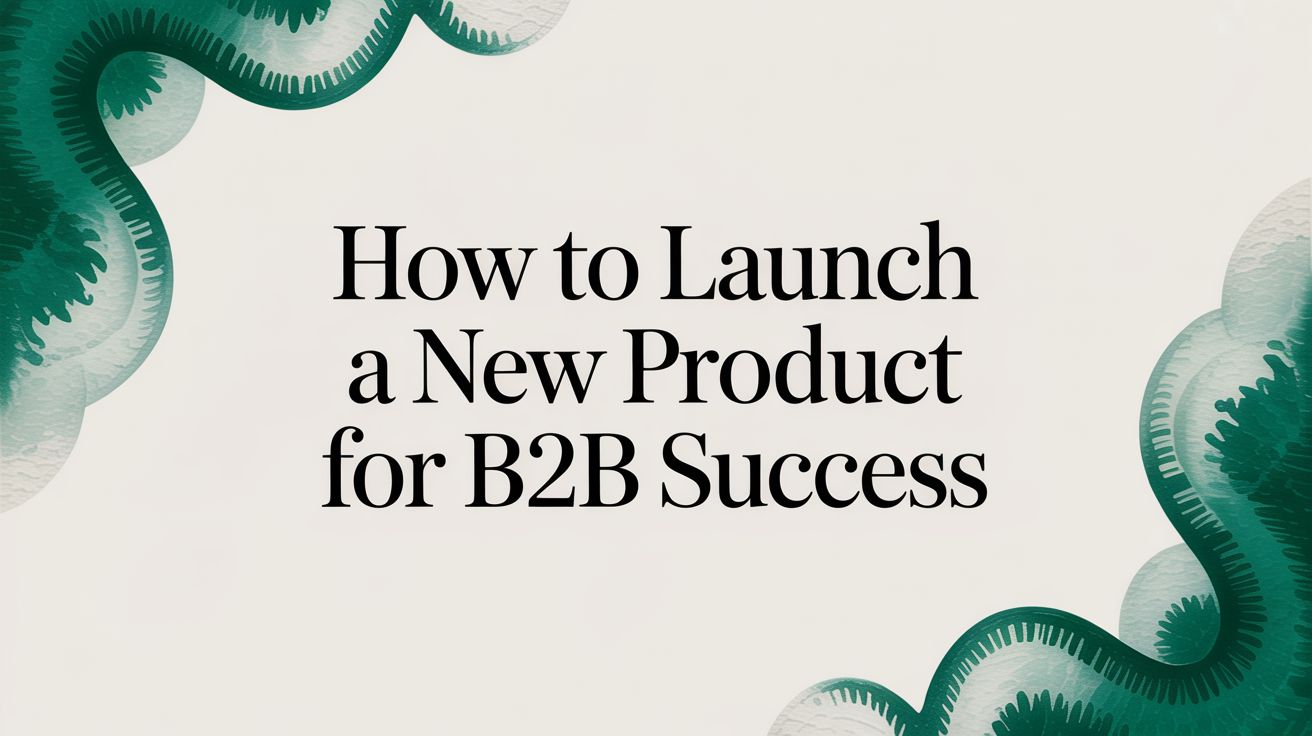
%20-%20white.svg)